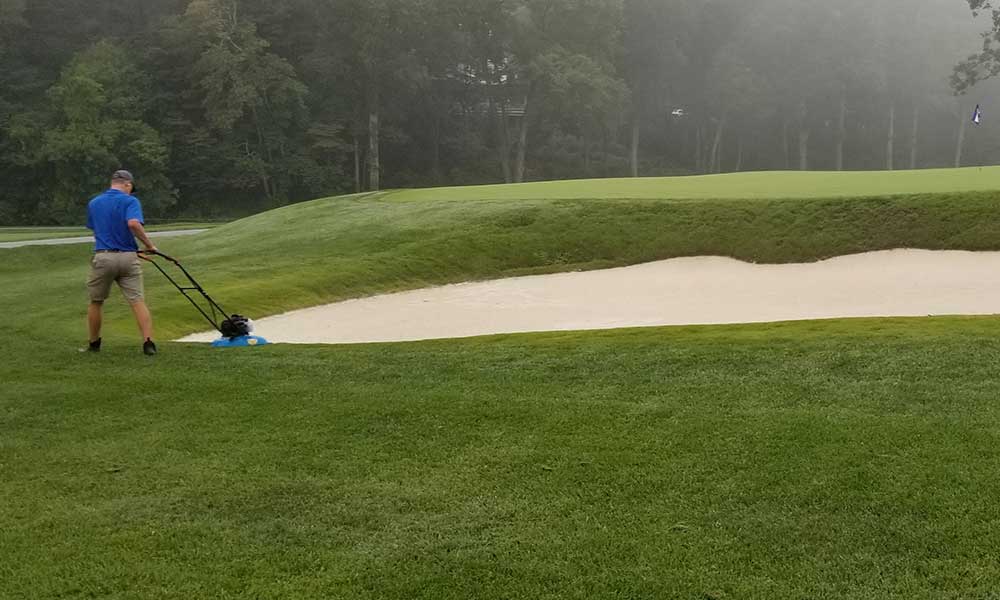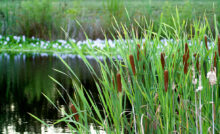Old Town Club


Maintenance friendly edges are key to the design of Better Billy Bunkers
As the Great Depression cruelly ravaged American families and businesses, a three-year old Augusta National Golf Club recalled Perry Maxwell, Dr. Alister Mackenzie’s ‘Midwest Associate,’ to Georgia for redesign work. Those were anything but heady, halcyon days for the fledgling club. Don’t forget: Augusta National was, at that time, ‘One jump ahead of the Sheriff,’ as Clifford Roberts famously wrote in a letter to Bobby Jones. But through Roberts and Jones’ single-minded dedication and stewardship, along with the protection of the Georgia Railroad Bank and Trust Company, the club endured. They survived, then thrived, their annual invitational tournament ultimately blossoming into the Masters – our yearly golf renewal, reunion, and revival.
Roberts was so enamored with Maxwell’s 1937 work at Augusta that he heartily recommended Maxwell for another design job, this time in Winston Salem, N.C. Charles Babcock, a scion of Reynolds Tobacco and a co-worker of Roberts in financial circles, owned a 1,000 acre parcel that would eventually include Wake Forest University and the Reynolds family estate. He needed an architect to design a golf course on the property. What he got was Old Town Club: the last great masterpiece of Perry Maxwell and the course that essentially brought to a rousing crescendo the close of the first Golden Age of Golf Course Architecture in America.
It is impossible to understate how important Old Town is to both Maxwell’s legacy and the study of golf design. He chose a stretch of terrain absolutely perfect for golf: 165 acres reminiscent of the UK moors. Rumbling, rugged terrain where he employed tumultuous undulations in the fairways, diagonal hazards, the Doctrine of Deception, and his fiendishly intricate green contours , all Maxwell’s greatest trademark design features are on display at Old Town. It’s as though you’ve been transported 100 years in the past and across the ocean.
But the man who gave us quintessential Golden Age courses such as Southern Hills, Prairie Dunes, and Crystal Downs had one more surprise in store: a great windswept heath where six holes join each other through interconnecting fairways, and three more abut it at either end.
What a majestic sight. Once the player crests the brow of the hill of the par-5 fourth fairway, he sees clear across the vast expanse of holes four, seven, eight, nine, 17, and 18, with the par-3 11th green abutting the shared tee box of the criss-crossing ninth and 18th holes, while the fifth and sixth holes adjoin along the end furthest from the clubhouse.
It’s a bold concept – six holes intersect with each other and three more attached, but with no rough. Instead a creek winds its way through, creating diagonal hazards in several places, and bunkers are cut almost exactly where the perfect drive should be placed. It’s these inter-connections between the fairways that form the backbone of the course’s indelible character. Everyone breathlessly agrees , they’ve seen nothing like Old Town before, and they love it for that.
Still, it took what many golf experts call the best restoration of Bill Coore and Ben Crenshaw’s lives to bring the course back to its glorious Golden Age roots. Old Town fell victim to the usual malaise that infected courses during the decades that followed WWII. Over-planting of trees, (with the resulting narrowing of playing corridors), cocooned the golfer within individual holes like a mummy in a sarcophagus. A focus on how the course looked (as opposed to how it played) kept it green and soft. And a desire to make the bunkers as maintenance-friendly as possible had them looking plain and tired. The Old Town of the late 20th century was nothing like the course Maxwell designed.
But when the trees came down, it opened up expansive vistas all across the tumbling topography. The wider fairways brought back lost playing angles, green were pulled back to the edge of their pads, and bunkers were given a naÏve fescue trim around them for an eminently natural texture and contrast. Many of them were completely reworked.
‘It was almost as though we were back in the 1930s, that’s how much attention to detail Bill and Ben gave to every bunker,’ explained golf course superintendent Crouch O’Neil. ‘We had modern equipment, but just like a sculptor, they’d study and discuss its subtleties like it was a work of art. When it finally got done, we’d step back and say to ourselves, ‘it looks better than it ever did.’ It was a minimalistic approach, and that’s exactly what we needed at Old Town.’
While the minimalist approach worked to make the bunkers look more Old World and rustic, yet more sustainable and maintainable, it was state-of-the-art technology that solved an agronomic problem: Better Billy Bunkers were employed to shore up bunkers that were formerly susceptible to erosion and rain.
‘We used the Better Billy Spray System, named after Billy Fuller, the old golf course superintendent at Augusta National who invented them,’ Crouch recalled. ‘The drainage in the bunkers is amazing, and we can be so much more flexible with the amount of slope and pitch we can put on a bunker.’
Since the restoration, players from across the globe have come to marvel at Old Town’s singularity. Its routing so ingeniously unique and its presentation (with no rough and interconnected fairways) so breathtakingly refreshing (yet old school) the true magic of the game can’t help but resonate within the player. That’s the moment of grace, when a round of golf becomes so much more than just playing 18 holes and hitting a ball around for three hours.
‘You get an education in golf design every time you play here,’ praised Coore. ‘It’s an amazing study in how to rout a golf course, especially with how small and hilly the plot of land is. And it’s a wonderful example of how to build internal green contours. The classic ‘Maxwell Rolls’ are here, just like at Southern Hills, Prairie Dunes, and Crystal Downs.’
Moreover, the course’s generous width, yet gargantuan fairway undulations make the golfer think carefully about every shot. An eminently natural defense to scoring, players have to shape shots in order to keep the ball on those tilted fairways, just like at Olympic Club. Once again, a great Golden Age architect shows us greater width does not equate to lower scores for he best golfers.
Maxwell often proved that you don’t need an ocean, a cliff-side, a river, a waterfall, a chasm, a desert, or any other eye candy to build a truly great golf course and, perhaps nowhere is that more true than at Old Town.
‘If you want to study routing, angles, and green contours, this is where you do it,’ Coore said.
DID YOU KNOW?
When asked if he did much studying while he was at Wake Forest, Lanny Wadkins said, ‘I saw the library every day. I aimed my tee shot on eight at the steeple.’
Recent Posts
Sir Nick Faldo and Himalayas Golf Launch ‘Golf in Small Spaces’ to Redefine Where the Game is Played
Golf is evolving, and Sir Nick Faldo is helping lead the charge. The six-time major…
Mark McCarel Joins EnP as Northeast Territory Sales Manager
Specialty fertilizer manufacturer EnP Investments is proud to welcome Mark McCarel as their Northeast Territory…
Heathrow Legacy Country Club’s Fazio Course Earns Audubon International Signature Sanctuary Certification
Audubon International—an environmentally focused non-profit organization offering members numerous certifications and conservation initiatives to protect…
South Carolina State Leaders Honor Green’s Superintendent Career
South Carolina’s House of Representatives today honored the career of golf course superintendent Chuck Green.…
Branson, Missouri: 5 Reasons Why it is a Must-Visit Travel and Golf Destination
Branson, Missouri, is booming as a must-visit destination for golf enthusiasts and travelers alike. Nestled…
Preview more than 1,000 rounds of golf available in GCSAA’s Rounds 4 Research online auction
The Golf Course Superintendents Association of America (GCSAA) Rounds 4 Research program offers golfers the…


